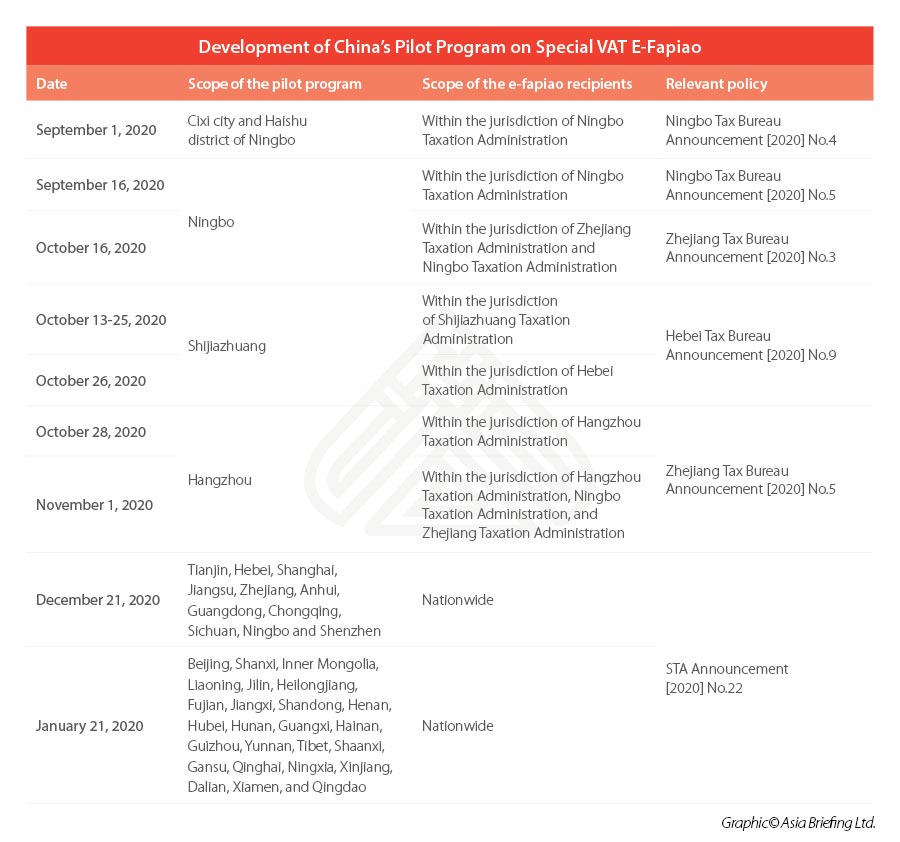China to Launch Electronic Special VAT Invoice Nationwide
- China’s pilot program on issuing electronic special VAT invoices, first trialed in Ningbo, Hangzhou, and Shijiazhuang, is being expanded to 11 regions from December 21, 2020 and then another 25 regions from January 21, 2021.
- China originally aimed to implement electronic special VAT invoice nationwide by the end of 2020. So far, the scope of electronic special VAT invoice recipients has been expanded to cover the whole country.
- With the pilot program being rolled out widely, companies are advised to prepare themselves for a digital transformation of the fapiao system.
Over the last few months, China has been quickly expanding the pilot program on electronic special value-added tax (VAT) fapiao (hereafter special VAT e-fapiao). So far, 11 regions – Tianjin, Hebei, Shanghai, Jiangsu, Zhejiang, Anhui, Guangdong, Chongqing, Sichuan, Ningbo and Shenzhen – have been added into the pilot scope, from December 21, 2020.
From January 21, 2021, the list will add 25 more regions – Beijing, Shanxi, Inner Mongolia, Liaoning, Jilin, Heilongjiang, Fujian, Jiangxi, Shandong, Henan, Hubei, Hunan, Guangxi, Hainan, Guizhou, Yunnan, Tibet, Shaanxi, Gansu, Qinghai, Ningxia, Xinjiang, Dalian, Xiamen, and Qingdao.
According to the Notice on the Implementation of Electronic VAT Invoices Among Newly Established Taxpayers (STA Announcement [2020] No.22), newly established taxpayers, the scope of which will be confirmed by provincial tax bureaus in the regions, will be entitled to issue special VAT e-fapiao.
The pilot program is another step forward in China’s ambition to digitize its large and intricate fapiao system. The country originally planned to fully implement the special VAT e-fapiao system nationwide by the end of 2020. By far, although the pilot scope is limited in 11 regions – only eligible taxpayers in listed regions can issue special VAT e-fapiao, e-fapiao recipients can be entities nationwide.
This article discusses why companies should track the development of China’s electronic fapiao system, analyzes the pilot program of electronic special VAT fapiao, and puts forwards suggestions on how companies can prepare for the digital transformation.
What are the advantages of special VAT e-fapiao?
According to the SAT announcement, electronic special VAT fapiao have the same legal effect, basic use, and basic usage regulations as paper special VAT fapiao.
However, compared with paper fapiao, e-fapiao are easier to acquire, deliver, manage, and endorse.
For example, e-fapiao can be acquired by applying through the electronic tax bureau, instead of needing to make a physical visit to the tax bureau’s service hall.
Selected pilot taxpayers can use the State Public Service Platform of Electronic VAT Invoice to issue the special VAT e-fapiao after obtaining the approval of invoice type and maximum invoice limit and receiving the U key – a tax control device containing the digital certificate, which taxpayers can use to log onto the State Public Service Platform of Electronic VAT Invoice.
Special VAT e-fapiao holders can log onto the Comprehensive Service Platform of VAT Invoice of pilot areas (like https://fpdk.ningbo.chinatax.gov.cn, https://fpdk.zhejiang.chinatax.gov.cn, or https://fpdk.hebei.chinatax.gov.cn) to directly authenticate special VAT e-fapiao online, instead of visiting the tax service hall in person or purchasing invoice scanning equipment to conduct the invoice authentication process, before using the special VAT e-fapiao for VAT input tax deduction or export tax rebate.
Entities and individuals can easily check and verify the VAT e-fapiao via the National VAT Invoice Verification Platform (https://inv-veri.chinatax.gov.cn/) or download the reader of VAT e-fapiao through the platform to verify the invoice and the validity of the electronic signature.
Moreover, special VAT e-fapiao can be permanently preserved. If the holder loses or damages the issued electronic special VAT fapiao, they can still check the e-fapiao on the National VAT Invoice Verification Platform (https://inv-veri.chinatax.gov.cn/) and download the original e-fapiao. If the paper copy of the e-fapiao is lost, the original e-fapiao can still be obtained from the invoice issuer.
To be noted, if taxpayers use the printed copy of a special VAT e-fapiao as tax receipts, they should at the same time keep the original VAT e-fapiao. And if a taxpayer has issued electronic invoices and the products are later returned or there are mistakes in the invoices, it should issue red-headlined special invoices.
Fully implementing special VAT e-fapiao by the end of 2020
China’s general VAT e-fapiao had already started being piloted in Beijing, Shanghai, Shenzhen, and Zhejiang province in August 2015 and then expanded to the rest of the country from 2016. In 2017, China began encouraging the use of general VAT e-fapiao, in particular, in certain service-based industries, such as e-commerce, telecommunication, and public utilities.
Based on the growth of the e-fapiao system over the past several years, this year, Beijing contemplated pushing the digitalization of special VAT fapiao – another type of VAT invoicing. Compared with the general VAT fapiao, the special VAT fapiao can be used to offset input VAT from output VAT.
On July 21, 2020, the State Council rolled out the Implementing Opinions on Further Optimizing the Business Environment to Better Serve Market Players (Guo Ban Fa [2020] No.24), setting a goal that “by the end of 2020, the electronic operation of special VAT invoices should be basically achieved, and main tax-related services should be basically handled online”.
Ten days later, the State Taxation Administration (STA) set its focus on the Yangtze River Delta (YRD) region. The Notice of the STA on Measures to Further Support and Serve the Integrated Development of the Yangtze River Delta Region (Shui Zong Han [2020] No.138), released on July 31, urged to “deepen the application of electronic VAT fapiao” in the YRD region and indicated that “some cities in the YRD region will be included in the first batch of electronic special VAT fapiao pilot scope.”
How companies should prepare for the special VAT e-fapiao?
Over time, when China’s advanced e-fapiao schemes are migrated to the cloud, where the speed of connections and seamless electronic file transfers can be achieved, it will be easier for governments and companies to capture, validate, and transmit invoice data.
For a company, the workload of its accounting teams will then be reduced to a certain extent with the paperless fapiao system. Easier access to business, financial, and tax data can enable the transparency and better management of the company’s financial status. At the same time, fapiao digitalization will also give Chinese tax bureaus more power on tax control, collection, and inspection. This can expose firms to a variety of tax-involved risks if they ignore the changes in the invoicing system and are not compliant in their fiscal and tax management.
Therefore, enterprises should track the pilot electronic invoicing program. While enjoying the convenience brought by electronic invoices, companies should implement processes and make necessary changes to avoid tax risks. Enterprise financial and accounting teams should promptly learn and familiarize themselves with the knowledge of VAT e-fapiao and upgrade their internal digitalized reimbursement process.
For further information or assistance in electronic fapiao management, please contact us at china@dezshira.com or tax@dezshira.com.
This article was originally published September 10, 2020. It was last updated on December 29, 2020.
About Us
China Briefing is written and produced by Dezan Shira & Associates. The practice assists foreign investors into China and has done so since 1992 through offices in Beijing, Tianjin, Dalian, Qingdao, Shanghai, Hangzhou, Ningbo, Suzhou, Guangzhou, Dongguan, Zhongshan, Shenzhen, and Hong Kong. Please contact the firm for assistance in China at china@dezshira.com.
We also maintain offices assisting foreign investors in Vietnam, Indonesia, Singapore, The Philippines, Malaysia, Thailand, United States, and Italy, in addition to our practices in India and Russia and our trade research facilities along the Belt & Road Initiative.
- Previous Article China Clarifies Deadlines for Filing Tax Returns in 2021
- Next Article EU, China Give Political Approval to Comprehensive Agreement on Investments






